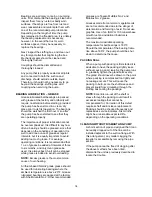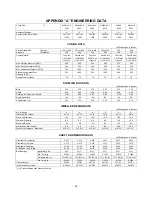
21
TROUBLE SHOOTING (CONT.)
CAUSES CURES
16. Impeller partially plugged.
See item 9.
a. Increase positive suction head on pump by lowering pump or
increasing suction pipe and fittings size.
b. Sub-cool suction piping at inlet to lower entering liquid temperature.
17. Cavitation; insufficient
NPSHA (Net Positive
Suction Head Available).
c. Pressurize suction vessel.
18. Defective impeller.
Inspect impeller, bearings and shaft. Replace if damaged or vane
sections badly eroded.
19. Foot valve too small or
partially obstructed.
Area through ports of valve should be at least as large as area of
suction pipe (preferably 1.5 times). If strainer is used, net clear area
should be 3 to 4 times area of suction pipe.
20. Suction inlet not immersed
deep enough.
If inlet cannot be lowered or if eddies through which air is sucked
persist when it is lowered, chain a board to suction pipe. It will be drawn
into eddies, smothering the vortex.
21. Wrong direction of
rotation.
Symptoms are an overloaded driver and about one third rated capacity
from pump. Compare rotation of motor with directional arrow on pump
casing. If rotation is correct with arrow, impeller may have to be turned
180°. (See CHANGING ROTATION.)
22. System head too high.
See item 4.
23. Defective mechanical seal. Repair or replace seal.
Not Enough Pressure
24. Speed too low.
See item 5.
25. Air leaks in suction piping
or stuffing box.
See item 11.
26. Mechanical defects.
See item 18.
27. Vortex at suction inlet.
See item 20.
28. Obstruction in liquid
passages.
Check to see if suction and discharge valves are fully open. Dismantle
pump and inspect passages and casing. Remove obstruction.
29. Air or gases in liquid.
May be possible to over rate pump to a point where it will provide
adequate pressure despite condition. Better provide gas separation
chamber on suction line near pump and periodically exhaust
accumulated gas. See item 17.
















































